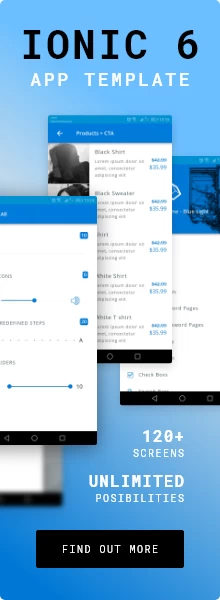Ionic vs React Native: Which one is right choice for you?
Wed.10.08.2022 BYPeople require easy access to useful data and information in the age of the digital revolution. Many businesses are moving away from desktop websites and toward sophisticated, user-friendly mobile applications. When using a hybrid mobile app framework, it is simple for developers to write code once and create a mobile application that functions across several platforms without further work. On the market, there are several hybrid mobile app frameworks. Ionic & React Native, one of the two greatest frameworks for creating hybrid mobile applications, is the topic of our discussion today.
Ionic basics
You can create top-notch, cross-platform mobile apps using the Ionic Framework, which blends hybrid and native technologies. It gives you the ability to build top-notch, cross-platform apps utilizing common web technologies like JavaScript, HTML, and CSS. The idea is to make it possible for you to write code once and then use it on desktop, web, iOS, and Android platforms. Every platform makes use of the same code base. To create Ionic apps, you may utilize Angular, Vue, or even React. In contrast to React Native, Ionic's tech stack is far more adaptable. Any web development framework may be used with Ionic thanks to the most recent Ionic 6 version.
React Native basics
With the same codebase, you can build native iOS and Android applications using the cross-platform React Native framework. It makes use of React and is developed in JavaScript. It was made open-source by Facebook in 2015, and since then, it has gained a lot of popularity. Using Javascript and React, you can build native mobile apps for iOS and Android using the React Native framework. Instead of using HTML, the UI components are built in JSX. Although JSX has the same appearance as other template languages, it has all of JavaScript's capabilities.
How Are They Similar?
The descriptions above make React Native and Ionic sound extremely comparable if you are just learning about them. Using conventional web technologies like JavaScript, CSS, and HTML, Ionic enables you to create mobile, desktop, and online applications. In a similar vein, React Native enables you to create native mobile apps utilizing JavaScript and the well-liked React JavaScript framework. This implies that using Ionic or React Native does not require any prior knowledge of native iOS or Android programming.
Hybrid versus native
Native to React Native
Cross-platform apps that are really native are created with React Native. A software program created in a particular programming language and designed specifically for the iOS or Android mobile platform is known as a native app.
Java is used to create native Android apps, whereas Swift or Objective-C is used to create native iOS apps. The core widgets in React Native are entirely native components, providing a seamless user experience. Although it was created with JavaScript and React, all of the components are native to iOS and Android. The benefit of React Native is that it uses a single code base to create native apps for both iOS and Android.
Given that you are using Javascript to code and are displaying platform-native components, it is quite astonishing. This is one of the factors that sets React Native-built apps apart from those made with other frameworks that rely on Web Views in terms of user experience.
Ionic is hybrid
A framework called Ionic makes it possible to create hybrid mobile apps. It builds apps that can be accessed on the web, desktop computers, or mobile devices using HTML, CSS, and JavaScript. A Web View is a piece of software used to create hybrid apps for mobile devices. Ionic framework components are used to create web apps, and they assemble the web pages you create for the app. HTML and CSS are used to develop Ionic apps, which are then presented in a Web View, a fully functional full-screen web browser.
Built-in capabilities from iOS, Android, and Windows devices may be integrated using the Ionic project's capability. Code reuse on several platforms is the aim. Hybrid apps won't immediately be able to use all of the device's features as a consequence. You'll use Cordova plugins in the Ionic framework to integrate native features. Ionic has certain restrictions on how much stuff can be presented on the screen at once because it produces its graphical components in a browser. Larger apps may execute more slowly as a result.
Hybrid technologies, such as Ionic, make it simple to transform online apps into Progressive Web Apps, which can be downloaded similarly to normal mobile apps.
React Native vs Ionic: Which one is more popular?
Both have a sizable community, considerable acceptance by major corporations, and widespread customer use of mobile applications. We may infer the following from the npmtrends data:
Ionic received far more downloads in 2017 than React Native, as shown in the graph above. Ionic is older than React Native, which is why this happened. It had fewer flaws and was more reliable at that time, making it more developed and prepared for usage in mobile development. After 2019, Facebook increased its efforts to make React Native a reliable library by regularly upgrading it, incorporating it into their own products, and showcasing the results.
Documentation
One of the most crucial components of a developer-friendly framework is documentation. Developers can easily solve difficulties and discover answers to their inquiries with the help of clear documentation. Ionic and React Native both offer excellent documentation. Even editable code samples with outputs are included in React Native's documentation. Ionic's documentation also makes up for its lack of editable code samples with the breadth of information offered. Even recommended practices for integrating your preferred web framework into Ionic are included in the documentation for Ionic.
Learning Curve Feasibility
Both frameworks' core SDKs contain JS by default. But they are not comparable. Getting the required components' design in React Native seems like a piece of cake thanks to the basic flex layout. The only restriction is that you must first be acquainted with CSS. You might also need to understand ES6, Flexbox, Axios for contacting APIs, and other requirements like Redux with React.
In contrast, installing Ionic is simpler thanks to npm instructions that install Cordova. You may access a comprehensive list of all Angularjs extensions and services with the element ngcordova. Most notably, Ionic has its own online school, Ionic Academy, which offers step-by-step lessons on various levels and greatly improves the efficiency and convenience of learning and constructing.
Developers community
It is a good idea to look into the community engagement for a technology when your team is reviewing it. Let's examine how the developer community and open-source contributions compare between React Native and Ionic. The GitHub statistics give a decent idea of how active the communities are for each framework. About 78k people have rated React Native, and the framework has over 1900 contributors. This suggests that it enjoys a great deal of local support.
Ionic, on the other hand, has just roughly 330 contributors and about 38k stars. Comparing this to React Native, there are fewer than half as many contributors.
Choose React Native if:
If your website or application is currently using React Native, go with it
Your development team is a React guru.
Dependency on native platforms is crucial to the success of any project.
You have ample time to develop your project and are willing to invest.
You already have enough money or a flexible budget to cover the high development costs.
When To Choose Ionic?
PWAs (Progressive Web Apps) are on your list of future development projects.
To create a web and mobile experience, you want to make use of the web development skills.
You're searching for a framework that ensures future high performance.
You want to create and expand mission-critical, enterprise-level apps.
You want to design an app for startups and have experience in web development.
The Ionic React framework is the perfect option for you if your application focuses on the concepts of Progressive Web Apps, Enterprise-Level Apps, Mission-Critical Apps, etc.
React Native is your best option if you want to build native app experiences that are solely intended for Android and iOS. React Native is an option if you also want to create a mobile application for users.
Conclusion
As you can see, we covered every significant difference between Ionic and React Native. The project you are working on will determine which of these 2 frameworks you should choose. Both frameworks offer benefits in particular ways. We are unable to declare one framework superior to another. Test out both frameworks in accordance with the needs of your project.




